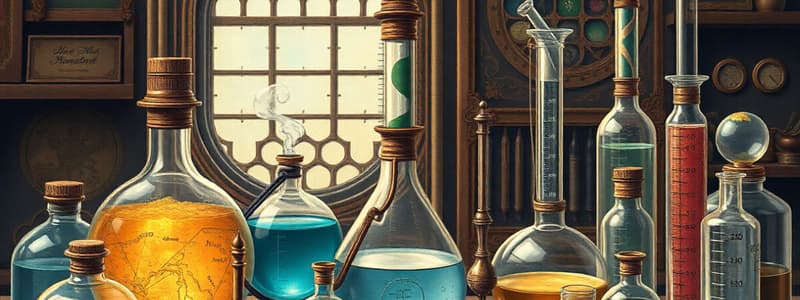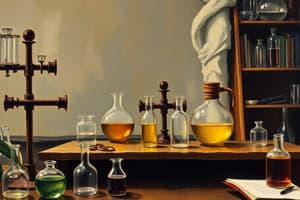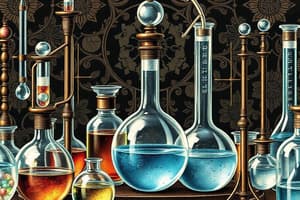Podcast
Questions and Answers
What is the primary function of a wash bottle in a laboratory setting?
What is the primary function of a wash bottle in a laboratory setting?
- To measure and transfer exact volumes of liquids
- To support porcelain crucibles while heating
- To dispense a wash solution to a specific area (correct)
- To cut glass rods precisely
Which tool is used primarily for heating certain metals to very high temperatures?
Which tool is used primarily for heating certain metals to very high temperatures?
- Crucible (correct)
- Evaporating dish
- Mohr pipet
- Bunsen burner
What purpose does a triangular file serve in a laboratory?
What purpose does a triangular file serve in a laboratory?
- To heat stable solid compounds
- To cut glass rods (correct)
- To weigh solids accurately
- To transfer liquids between vessels
Which piece of equipment is used to secure test tubes to a ringstand?
Which piece of equipment is used to secure test tubes to a ringstand?
What is the function of beaker tongs in a laboratory?
What is the function of beaker tongs in a laboratory?
When using a Bunsen burner, what equipment is typically placed on the iron ring?
When using a Bunsen burner, what equipment is typically placed on the iron ring?
What should never be used to transfer chemicals according to safety guidelines?
What should never be used to transfer chemicals according to safety guidelines?
What is the main use of a Mohr pipet in laboratory procedures?
What is the main use of a Mohr pipet in laboratory procedures?
What is the primary use of a beaker in a laboratory setting?
What is the primary use of a beaker in a laboratory setting?
Which laboratory equipment is specifically designed to hold and organize test tubes?
Which laboratory equipment is specifically designed to hold and organize test tubes?
What is a key characteristic of an Erlenmeyer flask?
What is a key characteristic of an Erlenmeyer flask?
When are gas collecting bottles utilized?
When are gas collecting bottles utilized?
What is the function of a graduated cylinder in laboratory experiments?
What is the function of a graduated cylinder in laboratory experiments?
What should never be done when using rubber stoppers in laboratory containers?
What should never be done when using rubber stoppers in laboratory containers?
Which of the following statements about test tube brushes is accurate?
Which of the following statements about test tube brushes is accurate?
What does red litmus paper indicate in a laboratory test?
What does red litmus paper indicate in a laboratory test?
Flashcards are hidden until you start studying
Study Notes
Basic Laboratory Equipment
- Beaker: Holds solids or liquids unlikely to release gases or splatter when stirred or heated.
- Erlenmeyer Flask: Holds solids or liquids that may release gases or splatter when stirred or heated.
- Florence Flask: Used for mixing chemicals and has a narrow neck to prevent splashing.
- Graduated Cylinder: Measures the volume of liquids.
- Gas Collecting Bottle: Used to collect large volumes of gases by water displacement.
- Test Tubes: Holds small volumes of liquids for reactions or experiments, often used for heating, typically available in two sizes: 13 x 100 mm and 10 x 75 mm.
- Test Tube Holder: Safely holds test tubes that are too hot to handle.
- Test Tube Brushes: Used to clean test tubes and graduated cylinders, choose the brush size appropriate for the container to avoid breaking it.
- Test Tube Racks: Holds and organizes test tubes on the laboratory counter, plastic racks may melt with very hot test tubes.
- Rubber Stoppers: Seals containers to prevent spillage or contamination, never heat a container with a stopper in place.
- Glass Stir Rod: Manually stirs solutions and can be used to transfer a single drop.
- Medicine Dropper: Transfers small volumes of liquid (less than 1 ml), equipped with a rubber bulb.
- Litmus Paper: Identifies acids and bases, red litmus paper turns blue in a base, blue litmus paper turns red in an acid.
- Forceps: Used to pick up small objects.
- Funnel: Aids in transferring liquids from one vessel to another.
- Mohr Pipet: Measures and delivers exact volumes of liquids.
- Wash Bottle: Dispenses a wash solution, typically distilled water, to a specific area.
- Weighing Boat: Used to weigh solids before transferring them to another vessel.
- Spatulas: Dispense solid chemicals from their containers, never use bare hands to handle chemicals.
- Beaker Tongs: Move beakers containing hot liquids.
- Bunsen Burner: Used to heat nonvolatile liquids and solids.
- Evaporating Dish: Used to heat stable solid compounds and elements.
- Crucible: Used for heating solids, particularly metals, to high temperatures.
- Clay Triangle: Supports porcelain crucibles when heated over a Bunsen burner.
- Crucible Tongs: Handle hot crucibles and other hot objects.
- Glass Plates: Used for semi-micro experiments such as drop reactions and testing acids and bases.
- Triangular File: Used to cut glass rod.
- Ringstand: A safe and convenient way to perform reactions that require heating with a Bunsen burner.
- Iron Rings: Connect to a ringstand to provide a stable, elevated platform for reactions.
- Utility Clamps: Used to secure test tubes, distillation columns, and burets to the ringstand.
- Double Buret Clamps: Secure burets, long graduated tubes used in titration.
- Wire Gauze: Placed on an iron ring to provide a stable platform for a beaker.
Studying That Suits You
Use AI to generate personalized quizzes and flashcards to suit your learning preferences.




